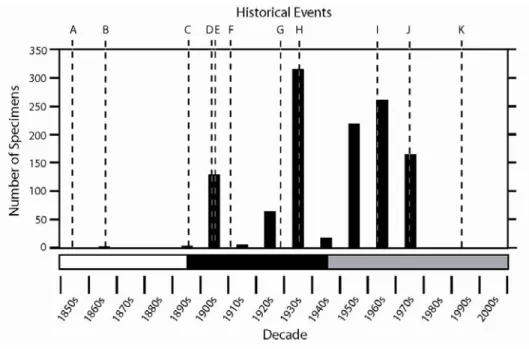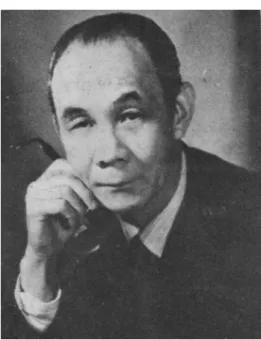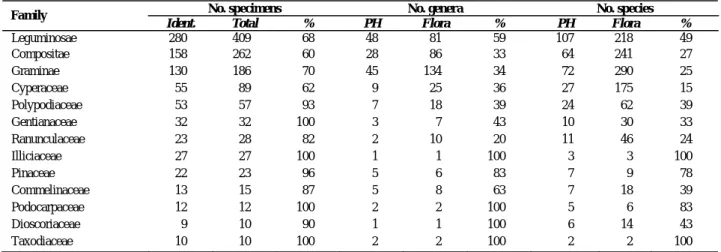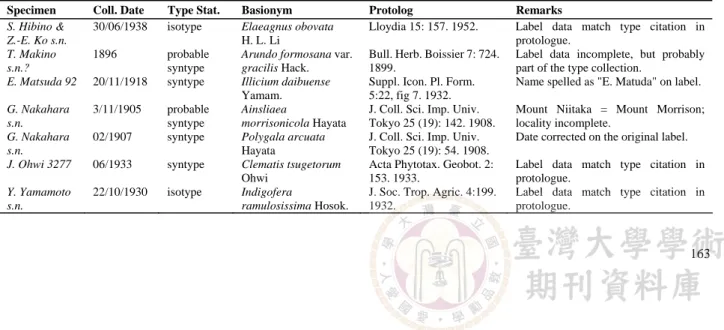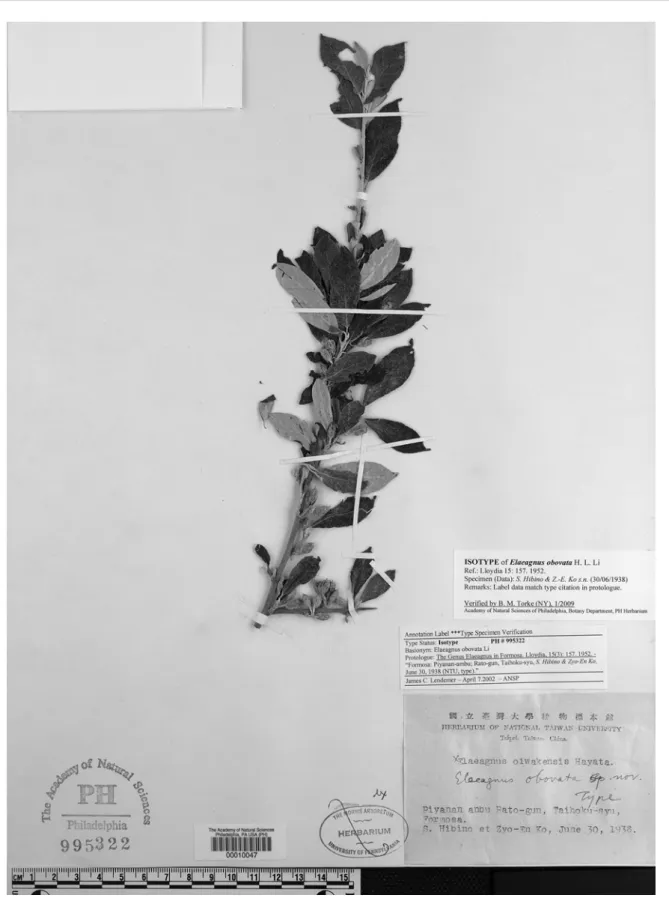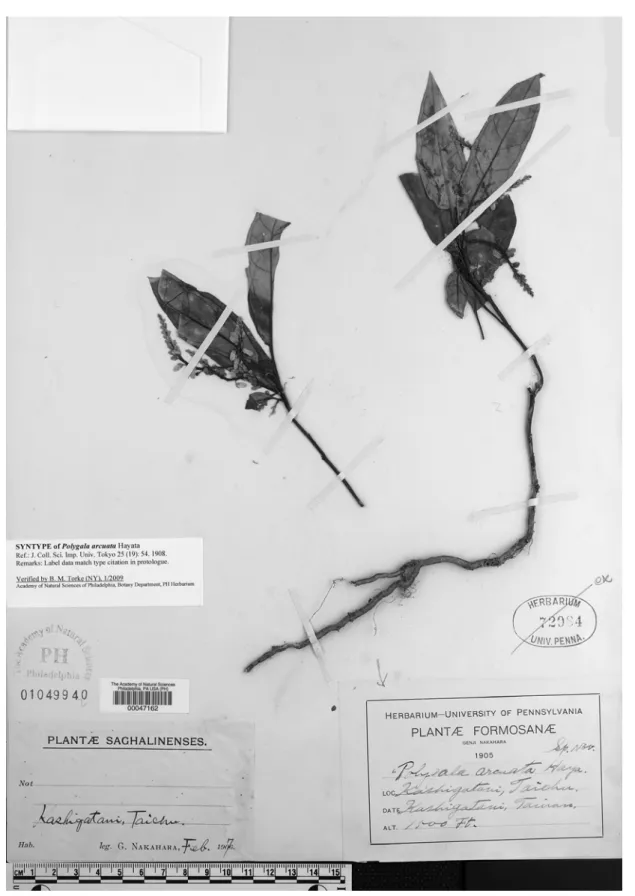BOTANICAL HISTORY
Unearthing a Forgotten Legacy of 20th Century Floristics: the Collection
of Taiwanese Plant Specimens in the Herbarium of the Academy of
Natural Sciences (PH)
Kuo-Fang Chung(1,4*), Benjamin M. Torke(2,4) and Kimberley Wu(3,4)
1. School of Forestry and Resource Conservation, National Taiwan University, 1, Sec. 4, Roosevelt Rd., Taipei 106, Taiwan. 2. The New York Botanical Garden, Institute of Systematic Botany, Bronx, NY 10458-5126, USA.
3. Barnard College, 3009 Broadway, New York, NY 10027, USA.
4. Authors are listed alphabetically; individual contributions were roughly equal.
* Corresponding author. Tel: 886-2-33664643; Fax: 886-2-23654520; Email: kuofangchung@ntu.edu.tw (Manuscript received 16 February 2009; accepted 14 April 2009)
ABSTRACT: The flora of Taiwan, comprising more than 4,400 vascular plant species, is one of the best studied of Asian floras. Herbarium collections of Taiwanese plants document the island's plant diversity and serve as important reference material for botanists and conservationists. Collections made during the Japanese colonial period in Taiwan (1895–1945) are of special interest in that they mark the first attempt at a truly comprehensive botanical inventory of the island. Unfortunately, these early collections are not widely distributed and are often in poor condition in Taiwanese herbaria. As such, the existence of a large, under-documented collection of Taiwanese plants in the Herbarium of the Academy of Natural Sciences-Philadelphia (PH), with many specimens collected during the Japanese colonial period, is likely to be of interest to the botanical and conservation communities in Taiwan and elsewhere. To determine the size and taxonomic scope of the collection, its historical and taxonomic importance, and the historical details of its assembly, a systematic survey was conducted in which all of the Taiwanese material was separated from the general collection at PH. Specimen label data were recorded from a phylogenetically diverse selection of plant families. The Academy’s collection was found to contain about 6,260 Taiwanese plant specimens, including representatives of 150 of the 198 seed plant families that occur in Taiwan. Within selected families, broad taxonomic representation of Taiwanese genera (33%–100%) and species (15%–100%) was encountered. Specimens in the collection were gathered between 1861 and 1977, with 90% the specimens dating to the periods 1905 (9%), 1929–1935 (28%), and 1955–1973 (53%). Over 60 collectors are represented. A preliminary search of the taxonomic literature indicates that significant type material is contained within the collection. Historical research revealed that most of the collection was assembled in Philadelphia by Hui-Lin Li (1911–2002), former professor of botany at the University of Pennsylvania and important figure in the history of floristic research in Taiwan.
KEY WORDS: Botanical collections, botanical history, Hui-Lin Li, Japanese colonial period in Taiwan, TAI herbarium.
INTRODUCTION
The diverse vascular plant flora of Taiwan, made up of tropical, subtropical, temperate, and alpine elements, constitutes approximately 4077 native species (Hsieh, 2002). At least 341 non-native species are introduced or naturalized (Wu et al., 2004; Peng and Yang, 2008). Although Taiwan shares strong floristic affinities with the Asian mainland, over a quarter of the native vascular plant species are endemic to the island (Hsieh, 2002). The botanical exploration of Taiwan began in the mid nineteenth century and can be classified into three historical periods: 1) 1854–1895: initial exploration by western explorers; 2) 1895–1945: the Japanese colonial period of exploration; and 3) 1946–present: the modern post-war era, dominated by Taiwanese and Chinese botanists. Some of the major events in this history are indicated in Fig. 1 [for fuller discussion, see Li (1963); Peng and Yang (1992); Ohashi (2009)].
The Japanese colonial period is of special interest in that it witnessed great intensification of botanical surveys (Fig. 1). Many endemic taxa were discovered and described during this period, and a large body of literature on the flora accumulated, laying the groundwork for the modern Flora of Taiwan series (Li et al., 1975–1979), now in it second edition (Editorial Committee of the Flora of Taiwan, 1993–2003). With the support of the Japanese Imperial Government, the Bureau of Forestry was founded in 1904 with a mandate to conduct botanical surveys in all parts of Taiwan. Specimens collected by Japanese botanists associated with the Bureau were deposited in the herbarium of Tokyo Imperial University in Japan (now the University of Tokyo Herbarium: TI). In 1928, Taihoku Imperial University was established in Taipei. A herbarium (now the National Taiwan University Herbarium-TAI) was founded at the University, and the functions of the Bureau were transferred to the University. From 1928 onwards, collections made by Japanese
Fig. 1. Temporal representation in the PH Herbarium of the three historical periods of botanical exploration in Taiwan based on a sample of 1197 databased specimens. The lower horizontal axis represents the decades spanned by the three periods of botanical exploration, with the horizontal bar below the axis indicating the European (white), Japanese (black), and modern (gray) periods. The black shaded vertical bars show the number of Taiwanese specimens at PH contained within each 10-year bin. Dashed vertical lines lettered on the upper horizontal axis denote significant historical events in floristic research and botanical exploration in Taiwan. A: Botanical exploration begins in 1854 when R. Fortune gathers a small number of specimens near Tansui in northern Taiwan. B: Swinhoe (1863) publishes ‘List of plants from the Island of Formosa, or Taiwan’ listing 246 Taiwanese plant species based on several years of exploration in coastal areas. C: Henry (1896) publishes ‘A list of the plants from Formosa’, an updated species list with 1283 species based on collections from coastal and lower montane zones. D: Botanical exploration intensifies in all parts of Taiwan under the sponsorship of the Japanese Imperial Government, particularly after the creation of the Bureau of Forestry in 1904. E: Matsumura and Hayata (1906) publish the ‘Enumeratio Plantarum’, describing many new species from Taiwan. F: The first of ten volumes of Hayata’s monumental ‘Icones Plantarum Formosanarum’ (Hayata, 1911–1921) is published, enumerating the rapidly growing collections of Taiwanese plant specimens in the Herbarium of Tokyo Imperial University. G: The Herbarium of Taihoku Imperial University (now National Taiwan University) is established in 1928 with Y. Kudo as director. H: Masamune (1936) publishes ‘Short Flora of Formosa’. I: Li (1963) publishes the ‘Woody Flora of Taiwan’. J: The first of six volumes of the ‘Flora of Taiwan’ is published. K: The second edition of the ‘Flora of Taiwan’ is published.
botanists in Taiwan were mainly deposited at TAI, with many duplicates also being sent to Japan. These collections and those resulting from the earlier activities of the Bureau were not widely distributed elsewhere. Prior to the installation of modern climate control systems in Taiwanese herbaria, the tropical climate of the island deteriorated the condition of many older collections, including many specimens gathered during the Japanese period and housed at TAI (Peng and Yang, 1992). As such, the existence of duplicates of these collections outside of Taiwan is noteworthy. One such collection is currently housed in the Herbarium of the Academy of Natural Sciences-Philadelphia (PH) in the United States. This collection was brought to the attention of the second author in 2007 during his tenure as a postdoctoral fellow at the Academy. In addition to containing substantial material dating to the Japanese colonial period, the collection also contains numerous specimens from the modern post-war era. Conversations
with Academy staff and correspondence with botanists in Taiwan suggested that the bulk of the collection was related to the work of Hui-Lin Li (1911–2002; Fig. 2), a major figure in the history of systematic research on the Taiwanese flora.
Li was born in Soochow (Suzhou today), China and received degrees in Biology from Soochow University in 1930 and Yenching University in 1932. He was granted a PhD from Harvard University in 1942, with research on the taxonomy and evolution of Pedicularis (Scrophulariaceae) in China (Li, 1948, 1949). As a Harrison Research Fellow (1943–1946), Li studied at the University of Pennsylvania (U-Penn), under the direction of Francis Pennel, curator of Botany at PH, and J. R. Schramm, chair of the Botany Department at U-Penn. Li attained the position of Professor of Biology at National Taiwan University in 1947 and remained in Taiwan until 1950. During this time, he began working toward a floristic treatment of the woody flora of the island. In
Fig. 2. Hui-Lin Li, ca. 1972 (with permission from the Archives of the Morris Arboretum of the University of Pennsylvania).
1951, he became a research associate of the Smithsonian Institution, where he continued his studies of the Taiwanese flora. In 1952, Li returned to Philadelphia as a research associate of the Morris Arboretum of U-Penn. His association with U-Penn led to his eventual appointment to Professor of Botany at the University in 1963 and Director of the Arboretum in 1972. Li was particularly productive during his tenure at U-Penn, during which time he completed the "Woody Flora of Taiwan" (Li, 1963) and served as organizer, contributor, and chairman of the Editorial Committee for the first edition of the Flora of Taiwan (Li et al., 1975–1979). In addition to his works on the Taiwanese flora, he published extensively on the floras of eastern Asia and North America and made important contributions in cytology, phytochemistry, domestication, horticulture, phytogeography, and the taxonomy of numerous plant groups, particularly the flowering plant family Scrophulariaceae (many constituent genera now subsumed in Orobanchaceae). Li published over 200 scientific papers, nine books, and numerous popular articles. More on Li's life and a comprehensive bibliography of his work is available in Li (1982). Although few of the Taiwanese specimens at PH bear his annotations, Li undoubtedly consulted these specimens while preparing treatments for the Woody Flora and the Flora of Taiwan. Many sheets bear stamps of the Morris Arboretum Herbarium (MOAR) or the University of Pennsylvania Herbarium (PENN), and a number of the specimens formerly housed at MOAR are cited in the Woody Flora (where they are denoted with
"M"). It appears that the bulk of the Tainwanese collections at PH were acquired as gifts from the Morris Arboretum or as part of the transfer of the entire PENN to PH in 1974 on permanent loan. Following Li's retirement from U-Penn in 1979, the collection of Taiwanese plants at PH fell into a state of disuse and neglect. Many of the specimens are still unidentified or bear annotations with outdated nomenclature. Furthermore, it seems that the existence of this relatively large and historically important collection is virtually unknown to researchers in Taiwan and elsewhere currently studying the Taiwanese flora; the PH collection has not been consulted in any of the recent revisionary studies of Taiwanese plants (see recent issues of Taiwania and the Botanical Bulletin of the Academia Sinica/Botanical Studies).
In the present contribution, we explore the scope and significance of the collection of Taiwanese plants at PH. We hope that this exercise will stimulate interest in the collection and lead to its improved curation and increased use by the scientific and conservation communities. Specifically, our objectives were to determine the size of the collection, to assess its taxonomic breadth and depth, and to ascertain the extent of its historical and taxonomic significance. We also carried out historical research to better understand the details by which the collection was assembled.
METHODS
To determine the size and taxonomic breadth of the collection, a comprehensive search of the PH vascular plant herbarium was conducted in which all Taiwanese material was systematically separated. Tallies were kept of the total number of Taiwanese specimens, the number of seed plant families represented, and the number of Taiwanese specimens in each family. Since pteridophytes are filed alphabetically by genus in the PH Herbarium, no attempt was made to tally numbers of pteridophyte families, but the total number of pteridophyte specimens was recorded. To determine the depth of taxonomic coverage and the degree of representation of particular time periods and collectors, a database was compiled in which the following data were recorded for selected families (Table 1): first collector, collection number, date of collection, family, genus, and species. In addition to the families listed in Table 1, data were also recorded from Agavaceae, Araceae, Cephalotaxaceae, Liliaceae, Palmae, Schisandraceae, and Taxaceae. Although the databased sample emphasizes gymnosperm and monocot families, mid-sized to large dicot families were also included. All specimens of the constituent genera of a single, relatively large pteridophyte family, Polypodiaceae, were also databased. Species identifications were taken from specimen labels or annotations. Outdated nomenclature
Table 1. Taxonomic coverage in the ten most frequently represented families that were sampled in a database of Taiwanese specimens housed at PH. Column subheadings are as follows: Ident. = number of collections identified to species with names accepted by Boufford et al. (2003) or with synonyms of accepted names; PH = from left to right, total number of genera and species represented in the PH collection; Flora = from left to right, the total number of genera and species native and naturalized in Taiwan, as recognized by Boufford et al. (2003); % = from left to right, the percentage of specimens identified to species with accepted names, the percentage of Taiwanese genera represented in the collection, and the percentage of Taiwanese species represented in the collection.
No. specimens No. genera No. species Family
Ident. Total % PH Flora % PH Flora %
Leguminosae 280 409 68 48 81 59 107 218 49 Compositae 158 262 60 28 86 33 64 241 27 Graminae 130 186 70 45 134 34 72 290 25 Cyperaceae 55 89 62 9 25 36 27 175 15 Polypodiaceae 53 57 93 7 18 39 24 62 39 Gentianaceae 32 32 100 3 7 43 10 30 33 Ranunculaceae 23 28 82 2 10 20 11 46 24 Illiciaceae 27 27 100 1 1 100 3 3 100 Pinaceae 22 23 96 5 6 83 7 9 78 Commelinaceae 13 15 87 5 8 63 7 18 39 Podocarpaceae 12 12 100 2 2 100 5 6 83 Dioscoriaceae 9 10 90 1 1 100 6 14 43 Taxodiaceae 10 10 100 2 2 100 2 2 100
was corrected according to names and concepts in Boufford et al. (2003) in conjunction with synonymy listings in the second edition of the Flora of Taiwan. A preliminary search for type specimens was conducted by comparing the databased collection with the type registrar at TAI (http://tai2.ntu.edu.tw/v2/enindex.htm) and by consulting the primary literature, with emphasis on Leguminosae. The vascular plant type registrar at PH was also consulted.
To better ascertain historical details by which the collection was assembled, historical research was conducted in the Library and Archives of the Academy of Natural Sciences, in the Herbarium and Library of the Morris Arboretum, and in the U-Penn Archives and Records Center, which houses an extensive collection of the papers and correspondences of Hui-Lin Li (www.archives.upenn.edu).
RESULTS
Comprehensive search of the PH vascular plant herbarium found a total of 6258 Taiwanese plant specimens, representing 150 of the 198 seed plant families that occur in Taiwan. The number of specimens per family ranged from 1 to 408. Leguminosae had the largest number (409), followed by Rubiaceae (275), Compositae (262), Lauraceae (231), Rosaceae (221), Euphorbiaceae (205), Graminae (186), Labiatae (175), Theaceae (157), Ericaceae (145), Moraceae (139), Urticaceae (115), Rutaceae (99), Verbenaceae (98), Fagaceae (95), Cyperaceae (89), Acanthaceae (88), Symplocaceae (88), Polygonaceae (84), and Myrsinaceae (82). Of the 48 seed plant families that were
not encountered, nearly all have 5 or fewer species in Taiwan; 24 are monospecific in the flora. Although pteridophyte families were not counted, a total of 761 pteridophyte specimens were encountered.
Of the databased families, Leguminosae had the largest number of specimens, followed by Compositae, Graminae, Cyperaceae, and Polypodiaceae (Table 1). The percentage of specimens identified to species with names accepted by Boufford (2003) or with synonyms of accepted names ranged from 60% (Compositae) to 100% (Gentianaceae, Illiciaceae, Podocarpaceae, and Taxodiaceae). Representation of Taiwanese genera within families ranged from 33% (Compositae) to 100% (Dioscoriaceae, Illiciaceae, Podocarpaceae, and Taxodiaceae); representation of species ranged from 15% (Cyperaceae) to 100% (Illiciaceae and Taxodiaceae). Leguminosae had the largest number of represented genera (48) and species (107). There was little in the data to suggest strong taxonomic bias in the makeup of the collection, although gymnosperm families tended to have better representation of genera and species than did monocot, dicot, or pteridophyte families.
The databased specimens were collected between 1861 and 1977 (Fig. 1). Each of the three major historical periods of botanical exploration in Taiwan are represented, although only a single specimen, Swinhoe s.n., a collection of an unidentified Tephrosia species (Leguminosae) gathered in 1862, dates to the initial phase (1854–1894). Of the remaining specimens, 45% are from the Japanese colonial period and 55% from the modern post-war period. About 90% of the specimens were gathered during three peaks: 1905 (9%), 1929–1935 (28%), and 1955–1973 (53%). Sixty-two collectors are represented in the
Table 2. The ten most frequently represented collectors of Taiwanese plant specimens in the PH Herbarium based on a sample of 1197 databased specimens. The time periods indicated span the years to which the bulk of the corresponding specimens at PH date.
Collector No. Coll. Period
M.-T. Kao T. Tanaka G. Nakahara T.-C. Huang S. Suzuki C.-C. Chuang T. Hosokawa C.-C. Hsu T.-I. Chuang C.-S. Kuo 149 139 107 83 74 70 67 57 54 49 1953–1972 1932–1934 1905–1906 1959–1973 1926–1935 1962–1967 1929–1932 1958–1960 1957–1962 1967–1972
databased material (as first collectors listed on labels). Of the 10 most frequently represented collectors (Table 2), four are Japanese botanists that were active during the Japanese colonial period, and six are Taiwanese botanists active during the modern post-war era. Specimens dating to the 1929–1935 and 1955–1973 peaks were gathered by a multitude of collectors, while the specimens from 1905 were gathered almost entirely by a single collector, G. Nakahara. We did not compile data on collection localities but did note that the specimens came from all parts of Taiwan. Our preliminary search for type material located seven types or probable types (Table 3; Figs. 3 & 4).
DISCUSSION AND CONCLUSIONS
This study meets our principle objectives to determine the size of the collection of Taiwanese specimens at PH, to assess its taxonomic coverage, and to ascertain its historical and taxonomic significance. Most of the specimens are duplicated at TAI, and many of the sheets bear TAI labels or labels from its predecessor, the Taihoku Imperial University Herbarium, but the condition of duplicates of older specimens is often superior at PH.
Taxonomic coverage is broad across and within seed plant families. Given the early dates of many of the specimens, it is perhaps not surprising to find that there is type material contained within the collection, as confirmed by our very preliminary search of the primary literature and herbarium type registrars (Table 3; Figs. 3 & 4). Although a more comprehensive search for type material was prohibited by time constraints, we are confident that the majority of types contained in the collection have yet to be identified as such.
The greatest significance of the collection probably lies in the large quantity of specimens (ca. 45% of the collection) collected during the Japanese colonial period, material that is generally not well represented outside of a few herbaria in Taiwan and Japan. The specimens collected by G. Nakahara in 1905 (about 9% of the collection) shortly after the establishment of the Bureau of Forestry by the Imperial Government are of special interest and mark the beginning of an intensification of botanical exploration in remote and under-explored parts of Taiwan that continued throughout the Japanese occupation. More generally, the collection is notable in that it spans much of the twentieth century, making it an important reference documenting the history of botanical exploration in Taiwan, and also serving as a barometer of floristic change during a period of unprecedented human-induced impacts on the flora.
As we initially hypothesized, nearly all of the Taiwanese collection at PH is closely linked to Hui-Lin Li's floristic research, most notably for the Woody Flora of Taiwan and for familial treatments in the first edition of the Flora of Taiwan. It is interesting to note that groups treated by Li in the Flora of Taiwan (e.g., gymnosperms, Aquifoliaceae, Caprifoliaceae, Illiciaceae, and Theaceae) tend to be over-represented in the PH collection relative to their species numbers in the Taiwanese flora. Although very few of the specimens in the PH collection were actually annotated by Li, a large percentage of
Table 3. Types or probable types in the collection of Taiwanese specimens at PH, based on preliminary search of the taxonomic literature and type registrars. Photographs of S. Hibino & Z.-E. Ko s.n. (isotype of Elaeagnus obovata) and G.
Nakahara s.n. (syntype of Polygala arcuata) are provided in Figs. 3 and 4, respectively.
Specimen Coll. Date Type Stat. Basionym Protolog Remarks
S. Hibino & Z.-E. Ko s.n.
30/06/1938 isotype Elaeagnus obovata
H. L. Li
Lloydia 15: 157. 1952. Label data match type citation in
protologue.
T. Makino s.n.?
1896 probable syntype
Arundo formosana var. gracilis Hack.
Bull. Herb. Boissier 7: 724. 1899.
Label data incomplete, but probably part of the type collection.
E. Matsuda 92 20/11/1918 syntype Illicium daibuense
Yamam.
Suppl. Icon. Pl. Form. 5:22, fig 7. 1932.
Name spelled as "E. Matuda" on label.
G. Nakahara s.n. 3/11/1905 probable syntype Ainsliaea morrisonicola Hayata
J. Coll. Sci. Imp. Univ. Tokyo 25 (19): 142. 1908.
Mount Niitaka = Mount Morrison; locality incomplete.
G. Nakahara s.n.
02/1907 syntype Polygala arcuata Hayata
J. Coll. Sci. Imp. Univ. Tokyo 25 (19): 54. 1908.
Date corrected on the original label.
J. Ohwi 3277 06/1933 syntype Clematis tsugetorum
Ohwi
Acta Phytotax. Geobot. 2: 153. 1933.
Label data match type citation in protologue.
Y. Yamamoto s.n.
22/10/1930 isotype Indigofera
ramulosissima Hosok.
J. Soc. Trop. Agric. 4:199. 1932.
Label data match type citation in protologue.
Fig. 3. Isotype of Elaeagnus obovata H. L. Li deposited at PH. The collection is S. Hibino & Z.-E. Ko s. n (year 1938). Note the National Taiwan University label and the stamp of the herbarium of the Morris Arboretum. See Table 3 for additional details.
Fig. 4. Syntype of Polygala arcuata Hayata deposited at PH. The collection is G. Nakahara s. n. (year 1907). Note the stamp and second label from the University of Pennsylvania Herbarium. See Table 3 for additional details.
sheets bear stamps of the herbaria of the Morris Arboretum, where Li was based between 1952 and 1974, and where he served as Acting Director (1971) and Director of the Arboretum (1972–1974), or of U-Penn, where Li was a Professor of Botany from 1963 to 1979. Li's appointments with U-Penn and the Arboretum coincide with his most productive periods of active research on the Taiwanese flora.
In recent years, about half of the specimens at MOAR, including the vast majority of East Asian specimens, were transferred to PH or to the United States National Arboretum (NA). A search of the MOAR in July of 2008 found very little Taiwanese material, nearly all of it postdating the tenure of Hui-Lin Li. Although many collections formerly housed at MOAR and cited in the Woody Flora have made their way into PH, others were not found during our investigation at PH, and so it is likely that they now reside at NA, possibly in significant quantity. The transfer of the PENN to PH in 1974 undoubtedly brought in a large influx of Taiwanese material, probably the majority of the PH Taiwanese collection. A document in the U-Penn Archive dating to the time of the transfer lists the "Herbarium of Hui-Lin Li" as containing 5508 "Flora of Taiwan mounted specimens," with an additional 108 specimens to be distributed, and 10 specimens needing labels. There is still a sizeable quantity of unmounted Taiwanese material at PH.
We found relatively few documents pertaining to the assembly of the collection in Philadelphia. Given Li's association with National Taiwan University, his election as an academician to the Academia Sinica in 1964, his chairmanship of the Editorial Committee of the Flora of Taiwan, and his strong collaborative connections to Taiwanese botanists, it is likely that the specimens were acquired by Li as gifts or via herbarium exchanges. Most of the specimens are duplicated at TAI and have TAI or Taihoku Imperial University labels, suggesting that distribution records may still be on file at National Taiwan University.
We hope that this contribution will stimulate interest in the collection of Taiwanese plants at PH, both within the Taiwanese community and abroad. Moreover, we hope that it will further a national agenda in Taiwan to recapture data from Taiwanese natural history collections in foreign institutions.
ACKNOWLEDGEMENTS
We thank Alina Freire-Fierro for giving us full access to the collection of Taiwanese plants at PH and for supplying digital images of specimens, Ernie Schuyler (PH) and the staff of the Morris Arboretum for providing historical background on the collection, and Ed Lonergan (PH volunteer) for bringing its
existence to the attention of BMT. Permission to access the library and herbarium of the Morris Arboretum and the papers of Hui-Lin Li at the University of Pennsylvania Archives and Records Center is deeply appreciated. KFC’s research at PH was supported by the McHenry Award of the Academy of Natural Sciences. KW's participation in the project was made possible through the US National Science Foundation's Research Experience for Undergraduates Program (Award #0353930).
LITERATURE CITED
Boufford, D. E., H. Ohashi, T.-C. Huang, C.-F. Hsieh, J.-L. Tsai, K.-C. Yang, C.-I Peng, C.-S. Kouh and A. Hsiao. 2003. A checklist of vascular plants of Taiwan. In: Huang, T.-C. et al. (eds.), Flora of Taiwan, 2nd ed. 6: 15-139. Editorial Committee, Dept. Bot., NTU, Taipei, Taiwan. Editorial Committee of the Flora of Taiwan, Second Edition
(eds.). 1993-2003. Flora of Taiwan, 2nd ed. Vols. 1–6. Editorial Committee, Dept. Bot., NTU, Taipei, Taiwan. Hsieh, C.-F. 2002. Composition, endemism and
phytogeographic affinities of the Taiwan flora. Taiwania 47: 298–310.
Li, A. S.-Y. 1982. A biographic sketch. In: Li, H.-L. Contributions to Botany: Studies in Plant Geography, Phylogeny and Evolution, Ethnobotany and Dendrological and Horticultural Botany, 4–8. Epoch Publishing Co., Ltd., Taipei, Taiwan.
Li, H.-L. 1948. A revision of the genus Pedicularis in China I. Proc. Acad. Nat. Sci. Philadelphia 100: 205378.
Li, H.-L. 1949. A revision of the genus Pedicularis in China II. Proc. Acad. Nat. Sci. Philadelphia 101: 1–214.
Li, H.-L. 1963. Woody Flora of Taiwan. Livingston Publishing Company. Narberth, Pennsylvania, USA.974pp.
Li, H.-L., T.-S. Liu, T.-C. Huang, T. Koyama and C. E. DeVol (eds.). 1975–1979. Flora of Taiwan, Vols. 1–6. Epoch Publishing Co., Ltd., Taipei, Taiwan.
Ohashi, H. 2009. Bunzo Hayata and His Contributions to the Flora of Taiwan. Taiwania 54: 1–27.
Peng, C.-I and Y.-P. Yang. 1992. Status and research of the seed plants of Taiwan. In: Peng, C.-I (ed.), The Biological Resources of Taiwan: A Status Report, 55–85. Institute of Botany, Academia Sinica, Taipei, Taiwan.
Peng, C.-I and C.-K. Yang. 2008. Current research and status of plant species in Taiwan. In: Shao, K.-T. (ed.), 2008 Workshop: Research and Status of Taiwan Species Diversity, 1–32. Biodiversity Research Center, Academia Sinica, Taipei, Taiwan. (in Chinese) [available at http://2008checklist.biodiv.tw/disc2008/index.html]
Wu, S.-H., C.-F. Hsieh and M. Rejmánek. 2004. Catalogue of the naturalized flora of Taiwan. Taiwania 49: 16–31.
費城自然科學院的臺灣植物標本館藏:一批被遺忘的臺灣植物資產
鍾國芳(1,4*)、Benjamin M. Torke(2,4)、Kimberley Wu(3,4)
1. 國立臺灣大學森林環境暨資源學系,10617 台北市羅斯福路四段 1 號,臺灣。
2. The New York Botanical Garden, Institute for Systematic Botany, Bronx, NY 10458-5126, USA. 3. Barnard College, 3009 Broadway, New York, NY 10027, USA.
4. 本文之三位作者貢獻相同,作者順序依英文姓氏之字母順序排列。
* 通信作者。Tel: 886-2-33664643; Fax: 886-2-2365-4520; Email: kuofangchung@ntu.edu.tw
(收稿日期:2009 年 2 月 16 日;接受日期:2009 年 4 月 14 日)
